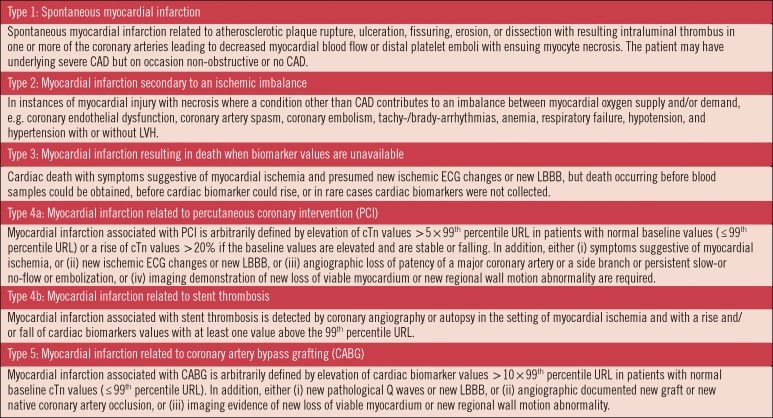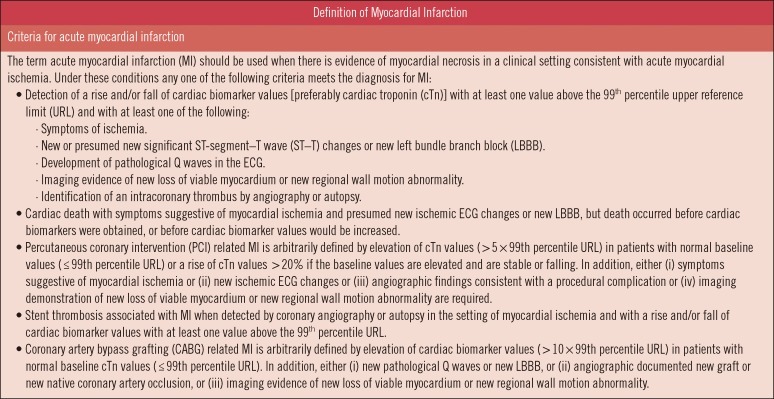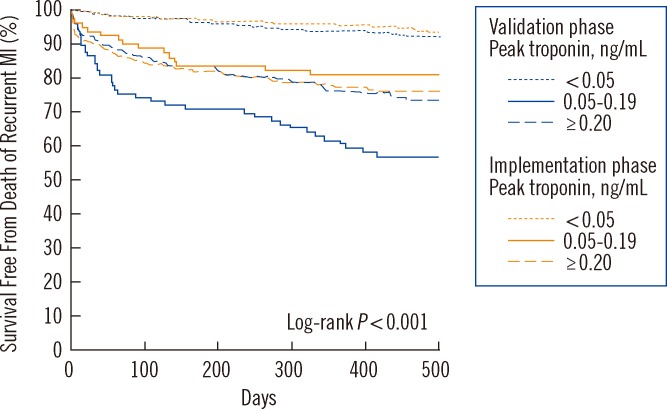Ann Lab Med.
2013 Sep;33(5):309-318. 10.3343/alm.2013.33.5.309.
The Role of Cardiac Biomarkers in the Diagnosis and Management of Patients Presenting with Suspected Acute Coronary Syndrome
- Affiliations
-
- 1Department of Medicine, Johns Hopkins Hospital, Baltimore, USA.
- 2Department of Pathology, University of Maryland School of Medicine, Baltimore, USA. rchristenson@umm.edu
- KMID: 1781335
- DOI: http://doi.org/10.3343/alm.2013.33.5.309
Abstract
- Myocardial infarction (MI) is the leading cause of death in the developed world. Biomarkers have an essential role in diagnosis, risk stratification, guiding management and clinical decision making in the setting of patients presenting with signs and symptoms of MI. Cardiac troponin (cTn) rose to prominence during the 1990s and has evolved to be the cornerstone for diagnosis of MI. The current criteria for MI diagnosis include a rise and/or fall in cTn with at least one value above the 99th percentile of the upper reference limit. Along with cTn, the natriuretic peptides B-type natriuretic peptide (BNP) and amino-terminal proBNP (NT-proBNP) have an important role in determining prognosis and guiding management. As assays for cTn have been evolved that are capable of reliably detecting smaller and smaller quantities in the blood, a dilemma has emerged as to how to use this new information. Several studies have attempted to answer this question and have shown that these lower concentrations of cTn have important prognostic significance and, more importantly, that intervention in these patients leads to improved clinical outcomes. New algorithms incorporating BNP, NT-proBNP, and more sensitive cTn assays hold promise for more rapid diagnosis or rule-out of MI, allowing for appropriate management steps to be initiated and more efficient and effective utilization of healthcare resources.
Keyword
MeSH Terms
Figure
Reference
-
1. Lloyd-Jones D, Adams R, Carnethon M, De Simone G, Ferguson TB, Flegal K, et al. Heart disease and stroke statistics--2009 update: a report from the American Heart Association Statistics Committee and Stroke Statistics Subcommittee. Circulation. 2009; 119:480–486. PMID: 19171871.2. Morrow DA, Cannon CP, Jesse RL, Newby LK, Ravkilde J, Storrow AB, et al. National Academy of Clinical Biochemistry Laboratory Medicine Practice Guidelines: clinical characteristics and utilization of biochemical markers in acute coronary syndromes. Circulation. 2007; 115:e356–e375. PMID: 17384331.
Article3. Thygesen K, Alpert JS, Jeffe AS, Simoons ML, Chaitman BR, White HD, et al. Third universal definition of myocardial infarction. J Am Coll Cardiol. 2012; 60:1581–1598. PMID: 22958960.
Article4. Thygesen K, Alpert JS, White HD. Joint ESC/ACCF/AHA/WHF Task Force for the Redefinition og Myocardial Infarction. Universal definition of myocardial infarction. J Am Coll Cardiol. 2007; 50:2173–2195. PMID: 18036459.5. Babuin L, Jaffe AS. Troponin: the biomarker of choice for the detection of cardiac injury. CMAJ. 2005; 173:1191–1202. PMID: 16275971.
Article6. Farah CS, Reinach FC. The troponin complex and regulation of muscle contraction. FASEB J. 1995; 9:755–767. PMID: 7601340.
Article7. Wu AH, Christenson RH. Analytical and assay issues for use of cardiac troponin testing for risk stratification in primary care. Clin Biochem. 2013; 46:969–978. PMID: 23623945.
Article8. Luepker RV, Apple FS, Christenson RH, Crow RS, Fortmann SP, Goff D, et al. Case definitions for acute coronary heart disease in epidemiology and clinical research studies: a statement from the AHA Council on Epidemiology and Prevention; AHA Statistics Committee; World Heart Federation Council on Epidemiology and Prevention; the European Society of Cardiology Working Group on Epidemiology and Prevention; Centers for Disease Control and Prevention; and the National Heart, Lung, and Blood Institute. Circulation. 2003; 108:2543–2549. PMID: 14610011.9. Wu AH, Lane PL. Metaanalysis in clinical chemistry: validation of cardiac troponin T as a marker for ischemic heart diseases. Clin Chem. 1995; 41:1228–1233. PMID: 7628112.
Article10. Heidenreich PA, Alloggiiamento T, Melsop K, McDonald KM, Go AS, Hlatky MA. The prognostic value of troponin in patients with non-ST elevation acute coronary syndromes: a meta-analysis. J Am Coll Cardiol. 2001; 38:478–485. PMID: 11499741.
Article11. Kelley WE, Januzzi JL, Christenson RH. Increases of cardiac troponin in conditions other than acute coronary syndrome and heart failure. Clin Chem. 2009; 55:2098–2112. PMID: 19815610.
Article12. Alpert JS, Thygesen K, Antman E, Bassand JP. Myocardial infarction redefined--a consensus document of The Joint European Society of Cardiology/American College of Cardiology Committee for the redefinition of myocardial infarction. J Am Coll Cardiol. 2000; 36:959–969. PMID: 10987628.13. Newby LK, Jesse RL, Babb JD, Christenson RH, De Fer TM, Diamond GA, et al. ACCF 2012 expert consensus document on practical clinical considerations in the interpretation of troponin elevations: a report of the American College of Cardiology Foundation task force on Clinical Expert Consensus Documents. J Am Coll Cardiol. 2012; 60:2427–2463. PMID: 23154053.14. Nomenclature and criteria for diagnosis of ischemic heart disease. Report of the Joint International Society and Federation of Cardiology/World Health Organization task force on standardization of clinical nomenclature. Circulation. 1979; 59:607–609. PMID: 761341.15. Cummins P, Perry SV. Troponin I from human skeletal and cardiac muscles. Biochem J. 1978; 171:251–259. PMID: 417726.
Article16. Wu AH, Apple FS, Gibler WB, Jesse RL, Warshaw MM, Valdes R Jr. National Academy of Clinical Biochemistry Standards of Laboratory Practice: recommendations for the use of cardiac markers in coronary artery diseases. Clin Chem. 1999; 45:1104–1121. PMID: 10388496.
Article17. Panteghini M, Pagani F, Yeo KT, Apple FS, Christenson RH, Dati F, et al. Evaluation of imprecision for cardiac troponin assays at low-range concentrations. Clin Chem. 2004; 50:327–332. PMID: 14656904.
Article18. Apple FS, Jesse RL, Newby LK, Wu AH, Christenson RH, Cannon CP, et al. National Academy of Clinical Biochemistry and IFCC Committee for Standardization of Markers of Cardiac Damage Laboratory Medicine Practice Guidelines: analytical issues for biochemical markers of acute coronary syndromes. Clin Chem. 2007; 53:547–551. PMID: 17384000.19. Apple FS, Collinson PO. IFCC Task Force on Clinical Applications of Cardiac Biomarkers. Analytical characteristics of high-sensitivity cardiac troponin assays. Clin Chem. 2012; 58:54–61. PMID: 21965555.
Article20. Keller T, Münzel T, Blankenberg S. Making it more sensitive: the new era of troponin use. Circulation. 2011; 123:1361–1363. PMID: 21422384.21. Melanson SE, Morrow DA, Jarolim P. Earlier detection of myocardial injury in a preliminary evaluation using a new troponin I assay with improved sensitivity. Am J Clin Pathol. 2007; 128:282–286. PMID: 17638663.
Article22. Reichlin T, Hochholzer W, Bassetti S, Steuer S, Stelzig C, Hartwiger S, et al. Early diagnosis of myocardial infarction with sensitive cardiac troponin assays. N Engl J Med. 2009; 361:858–867. PMID: 19710484.
Article23. Jesse RL. On the relative value of an assay versus that of a test: a history of troponin for the diagnosis of myocardial infarction. J Am Coll Cardiol. 2010; 55:2125–2128. PMID: 20447536.24. Mills NL, Churchhouse AM, Lee KK, Anand A, Gamble D, Shah AS, et al. Implementation of a sensitive troponin I assay and risk of recurrent myocardial infarction and death in patients with suspected acute coronary syndrome. JAMA. 2011; 305:1210–1216. PMID: 21427373.
Article25. Jeremias A, Gibson CM. Narrative review: alternative causes for elevated cardiac troponin levels when acute coronary syndromes are excluded. Ann Intern Med. 2005; 142:786–791. PMID: 15867411.
Article26. Wu AH. Interpretation of high sensitivity cardiac troponin I results: reference to biological variability in patients who present to the emergency room with chest pain: case report series. Clin Chim Acta. 2009; 401:170–174. PMID: 19135041.
Article27. Giannitsis E, Becker M, Kurz K, Hess G, Zdunek D, Katus HA. High-sensitivity cardiac troponin T for early prediction of evolving non-ST-segment elevation myocardial infarction in patients with suspected acute coronary syndrome and negative troponin results on admission. Clin Chem. 2010; 56:642–650. PMID: 20167697.
Article28. Casals G, Filella X, Augé JM, Bedini JL. Impact of ultrasensitive cardiac troponin I dynamic changes in the new universal definition of myocardial infarction. Am J Clin Pathol. 2008; 130:964–968. PMID: 19019775.
Article29. Apple FS, Pearce LA, Smith SW, Kaczmarek JM, Murakami MM. Role of monitoring changes in sensitive cardiac troponin I assay results for early diagnosis of myocardial infarction and prediction of risk of adverse events. Clin Chem. 2009; 55:930–937. PMID: 19299542.
Article30. Reichlin T, Irfan A, Twerenbold R, Reiter M, Hochholzer W, Burkhalter H, et al. Utility of absolute and relative changes in cardiac troponin concentrations in the early diagnosis of acute myocardial infarction. Circulation. 2011; 124:136–145. PMID: 21709058.
Article31. Reichlin T, Schindler C, Drexler B, Twerenbold R, Reiter M, Zellweger C, et al. One-hr rule-out and rule-in of acute myocardial infarction using high-sensitivity cardiac troponin T. Arch Intern Med. 2012; 172:1211–1218. PMID: 22892889.32. Riezebos RK, Laarman GJ, Tijssen JG, Verheugt FW. The value of N-terminal proB-type natriuretic peptide for early identification of myocardial infarction in patients with high-risk non-ST-elevation acute coronary syndromes. Clin Chem Lab Med. 2011; 49:1359–1365. PMID: 21692686.
Article33. Jernberg T, James S, Lindahl B, Johnston N, Stridsberg M, Venge P, et al. Natriuretic peptides in unstable coronary artery disease. Eur Heart J. 2004; 25:1486–1493. PMID: 15342167.
Article34. Ordonez-Llanos J, Collinson PO, Christenson RH. Amino-terminal pro-B-type natriuretic peptide: analytic considerations. Am J Cardiol. 2008; 101:9–15. PMID: 18243867.
Article35. Zeng X, Li L, Su Q. The prognostic value of Nterminal probrain natriuretic peptide in nonST elevation acute coronary syndromes a meta-analysis. Clin Chem Lab Med. 2012; 50:731–739. PMID: 22624152.
Article36. Truong QA, Bayley J, Hoffmann U, Bamberg F, Schlett CL, Nagurney JT, et al. Multi-marker strategy of natriuretic peptide with either conventional or high-sensitivity troponin-T for acute coronary syndrome diagnosis in emergency department patients with chest pain: from the "Rule Out Myocardial Infarction using Computer Assisted Tomography" (ROMICAT) trial. Am Heart J. 2012; 163:972–979.e1. PMID: 22709749.
Article37. Melki D, Lind S, Agewall S, Jernberg T. Prognostic value of combining high sensitive troponin T and N-terminal pro B-type natriuretic peptide in chest pain patients with no persistent ST-elevation. Clin Chim Acta. 2012; 413:933–937. PMID: 22366164.
Article38. Mathewkutty S, Sethi SS, Aneja A, Shah K, Iyengar RL, Hermann L, et al. Biomarkers after risk stratification in acute chest pain (from the BRIC Study). Am J Cardiol. 2013; 111:493–498. PMID: 23218997.
Article39. Scirica BM, Kadakia MB, de Lemos JA, Roe MT, Morrow DA, Li S, et al. Association between Natriuretic Peptides and Mortality among Patients Admitted with Myocardial Infarction: a Report from the ACTION Registry(R)-GWTGTM. Clin Chem. 2013; doi: 10.1373/clinchem.2012.198556 [Epub ahead of print].
- Full Text Links
- Actions
-
Cited
- CITED
-
- Close
- Share
- Similar articles
-
- Risk Stratification of Acute Coronary Syndrome
- Usefulness of Ergonovine Echocardiography in Patients with Acute Coronary Syndrome and Suspected Variant angina
- Early Diagnosis and Management of Non ST-Segment Elevation Acute Myocardial Infarction
- Diagnosis and management of acute coronary syndrome
- A Case of Partial Congenital Pericardial Defect Presenting as Acute Coronary Syndrome





